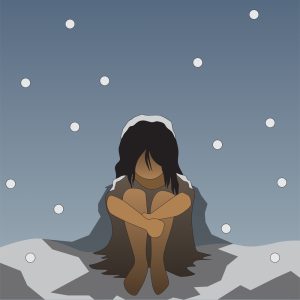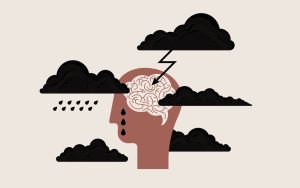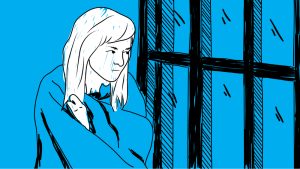Seasonal Depression or Seasonal Affective Disorder (SAD) is considered a major depressive disorder. This particular type of depression exist with the turns of the season, most prominently as Summer turns to Fall and the days become shorter and the weather cooler and more wet. The weather change and lack of light can create within the brain an altered chemistry While negative mindset can play a role, most who experience Seasonal Affective Disorder already have a history with depression. The early darkness, change of biorhythms, aligned with colder weather tend to force individuals inside and quartered with less exercise and social interaction.

Coupled with less vitamin D that sustains higher levels or serotonin, individuals can experience SAD. While 20 percent of the population experiences Winter Blues, especially after Christmas, those with SAD experience a true depression. Like all depression, individuals will lose interest in life, isolate, become anxious, feel bad and low about sense of self, lack energy, and have difficulties interacting with others. The Cleveland Clinic in its article, “Seasonal Depression (Seasonal Affective Disorder)” gives a comprehensive review of the disorder, as well as possible treatment options and ways to reduce its severity. The article states,
“If you have symptoms of seasonal affective disorder (SAD), don’t try to diagnose yourself. See your healthcare provider for a thorough evaluation. You may have another reason for your depression. Many times, seasonal affective disorder is part of a more complex mental health condition. Your provider may refer you to a psychiatrist or psychologist. These mental health professionals will ask you about your symptoms. They’ll consider your pattern of symptoms and decide if you have seasonal depression or another mood disorder. You may need to fill out a questionnaire to determine if you have SAD.”
“Seasonal Depression (Seasonal Affective Disorder)”. Cleveland Clinic. (2022).
To review the entire article, please click here
Commentary
Of the 5 percent of the population more prone to SAD, those who have a family history of depression, have a greater chance of experiencing it. Obviously, those who suffer from it also live in temperate areas in the Northern and Southern Hemispheres who experience the four seasons. Interesting enough, some individuals can experience SAD during Summer months as well. To be diagnosed, mental healthcare professionals will ask for a case history and only if one has experienced depression correlated with seasonal change two straight seasons can one possibly be labeled with SAD.

Again SAD is more than merely the Winter Blues, but a true depression in all of its fury. Individuals will suffer the classical physical and mental symptoms associated with depression with the turn of the season. The depression is related to brain chemistry and hence it is important for many to be prescribed an anti-depressant by a mental healthcare professional. The need to balance the serotonin is key in helping most. In addition, supplementing Vitamin D is critical. Many individuals in temperate zones, especially during the Winter, exhibit extremely low levels of vitamin D in the body. This is not merely an issue for those suffering from SAD, but also anyone who lives in areas with less sun over an extended period of time.
For some, cognitive behavioral therapy or CBT can be beneficial. Talking about the situation and understanding how SAD works and how to reframe things can help some individuals better cope. Reframing can look at the positives of the months during Winter and some of the experiences that others do not have, such as the beauty of fresh snow upon the trees, or Winter sports, or particular festivals pertaining to the season. One can create a cozy Winter atmosphere that brings joy to oneself inside. Whether its a fire, or comfortable slippers, the little things can make oneself feel better. In addition, individuals should attempt to do special things during the darker months. At least once a week, one should attempt to plan something to look forward to despite the bad weather. Most importantly, exercise is critical to good health but also mental health. The movement of the body, the heart rate, and physical motions can help neurotransmitters better operate in the brain. Many individuals “hibernate” the Winter away and eat poorly and sleep too much. It is so important to step outside, walk, or go to the gym during Winter. It is essential for both physical and mental health.

An extreme treatment for those with severe SAD can turn to light therapy. White light at a higher level than regular lighting in the house can be set up throughout the house. The treatment encourages more vitamin D and also more serotonin in the body. While the therapy can be successful, it can also carry risks causing potential eye damage if not properly utilized, as well as headaches or migraines for some. Moderate and safe use of it is an important rule to follow with light therapy.
Conclusion
Please also review AIHCP’s Grief Counseling Certification and see if it meets your academic and professional goals. The program is online and independent study and open to qualified professionals seeking a four year certification in Grief Counseling. It is important to note that while many grief counselors are also licensed counselors, only licensed counselors can discuss and treat Seasonal Depression. Pastoral and non-licensed counselors can discuss it with a client but must refer those who exhibit signs of it to a licensed professional who can treat the pathological condition.

For those who do suffer from SAD, it is important to seek treatment and utilize coping strategies. While Winter may not be favorite season of the year for many, it does not need to become a horrific experience. There is joy and light in any season and how one operates and maintains a schedule is key to keeping healthy and strong during the long Winter months.
Additional Resources
“What is seasonal affective disorder?”. National Institute of Mental Health. Access here
“Seasonal affective disorder (SAD)”. Mayo Clinic. (2021). Access here
“What to Know About Seasonal Depression”. Seo, H. (2022). New York Times. Access here
“14 Ways to Ease Seasonal Depression”. Orenstein, B. & Pugle, M. (2023). Everyday Health. Access here
